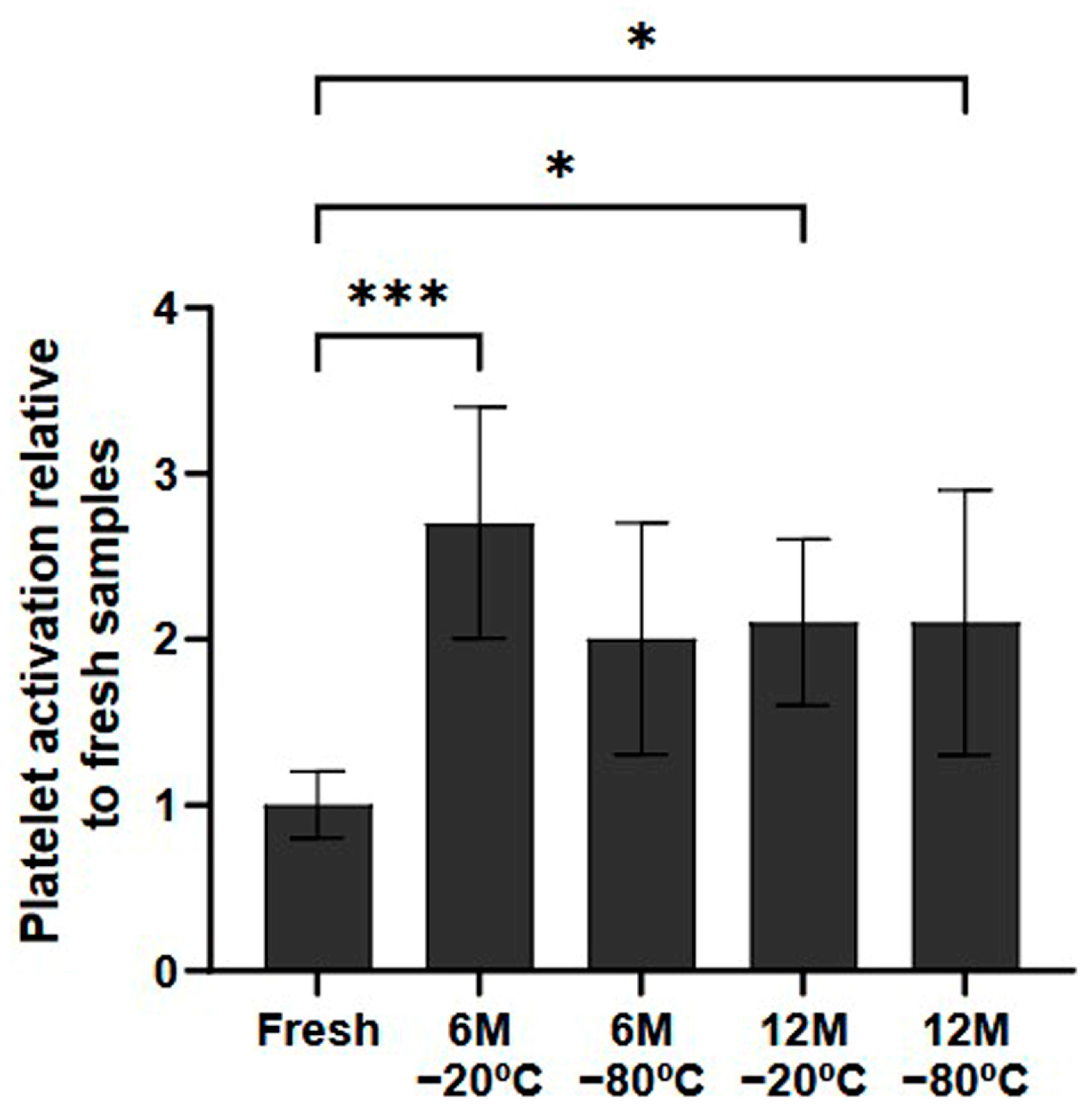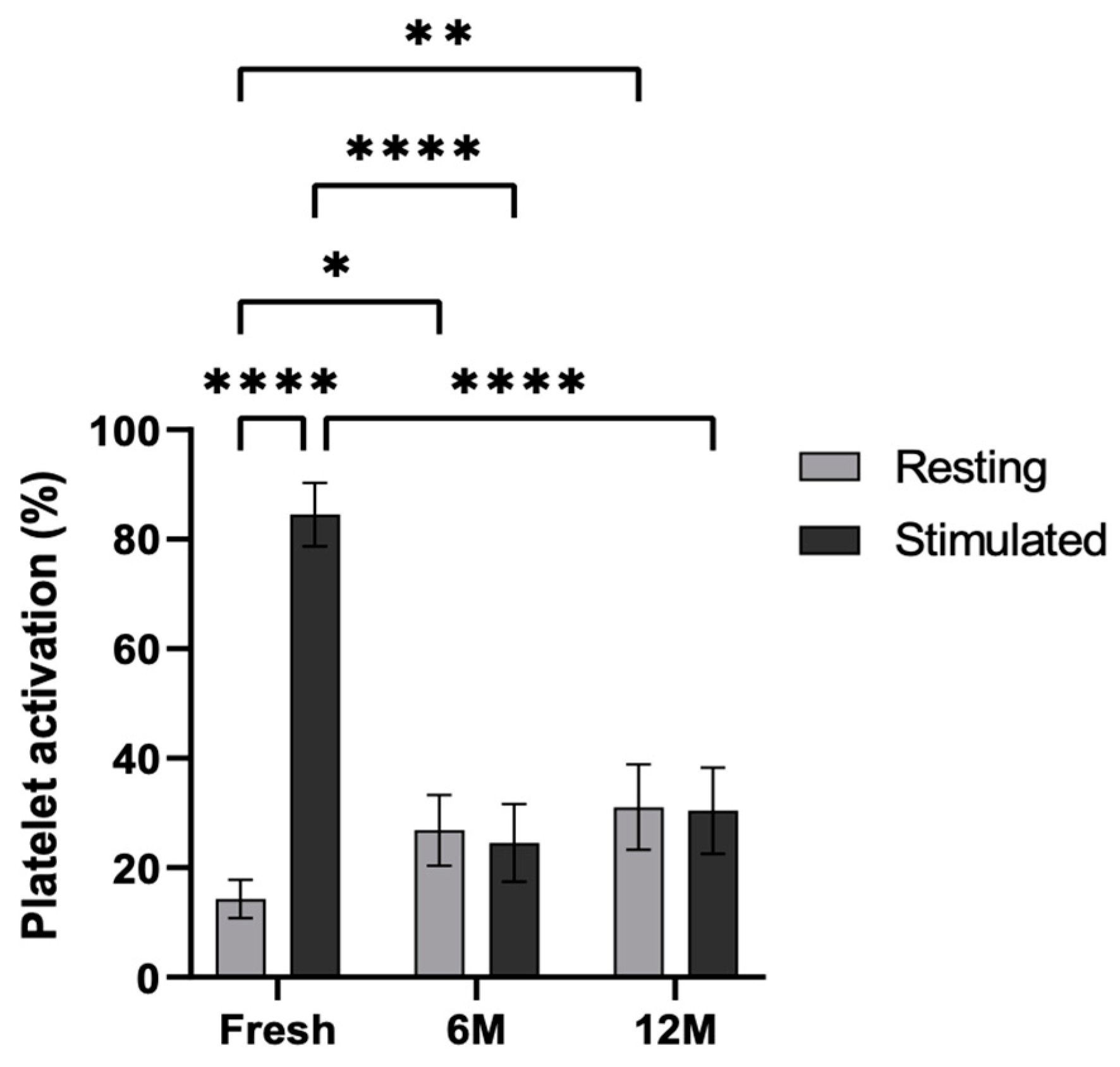The Effect of Long-Term Cryopreservation on the Properties and Functionality of Platelet-Rich Plasma
Abstract
1. Introduction
2. Results
2.1. Platelet-Rich Plasma Characterization
2.2. Effect of Freezing on Platelet Concentration, Size and Fibrinogen Levels
2.3. Freezing Effect on Platelet Activation
2.4. Growth Factor Profile After Cryopreservation
2.5. Study of Platelet Functionality After Platelet Activation upon Cryopreservation
2.6. Platelet Morphology After Platelet Freezing
2.7. Cellular Bioactivity of Cryopreserved Platelet-Rich Plasma
3. Discussion
4. Materials and Methods
4.1. Donors
4.2. Platelet-Rich Plasma and Platelet Lysate Obtaining Procedure
4.3. Platelet-Rich Plasma and Platelet Lysate Preservation
4.4. Measurement of Platelet Number, Size and Fibrinogen Levels
4.5. Platelet Activation Capacity Measurement
4.6. Platelet Morphology Study
4.7. Measurement of Growth Factor Levels
4.8. Cell Culture
4.9. Cell Viability Assay
4.10. Statistical Analysis
5. Conclusions
Author Contributions
Funding
Institutional Review Board Statement
Informed Consent Statement
Data Availability Statement
Acknowledgments
Conflicts of Interest
References
- Moreno-Pérez, V.; Ayala, F.; Fernandez-Fernandez, J.; Vera-Garcia, F.J. Descriptive Profile of Hip Range of Motion in Elite Tennis Players. Phys. Ther. Sport. 2016, 19, 43–48. [Google Scholar] [CrossRef]
- Patel, S.; Gahlaut, S.; Thami, T.; Chouhan, D.K.; Jain, A.; Dhillon, M.S. Comparison of Conventional Dose Versus Superdose Platelet-Rich Plasma for Knee Osteoarthritis: A Prospective, Triple-Blind, Randomized Clinical Trial. Orthop. J. Sports Med. 2024, 12, 23259671241227863. [Google Scholar] [CrossRef]
- Everts, P.; Onishi, K.; Jayaram, P.; Lana, J.F.; Mautner, K. Platelet-Rich Plasma: New Performance Understandings and Therapeutic Considerations in 2020. Int. J. Mol. Sci. 2020, 21, 7794. [Google Scholar] [CrossRef]
- El-Sharkawy, H.; Kantarci, A.; Deady, J.; Hasturk, H.; Liu, H.; Alshahat, M.; Van Dyke, T.E. Platelet-Rich Plasma: Growth Factors and pro- and Anti-Inflammatory Properties. J. Periodontol. 2007, 78, 661–669. [Google Scholar] [CrossRef] [PubMed]
- Pavlovic, V.; Ciric, M.; Jovanovic, V.; Stojanovic, P. Platelet Rich Plasma: A Short Overview of Certain Bioactive Components. Open Med. 2016, 11, 242–247. [Google Scholar] [CrossRef]
- Alsousou, J.; Thompson, M.; Hulley, P.; Noble, A.; Willett, K. The Biology of Platelet-Rich Plasma and Its Application in Trauma and Orthopaedic Surgery: A review of the literature. J. Bone Jt. Surgery. Br. Vol. 2009, 91, 987–996. [Google Scholar] [CrossRef] [PubMed]
- Padilla, S.; Sánchez, M.; Orive, G.; Anitua, E. Human-Based Biological and Biomimetic Autologous Therapies for Musculoskeletal Tissue Regeneration. Trends Biotechnol. 2017, 35, 192–202. [Google Scholar] [CrossRef]
- Heijnen, H.; van der Sluijs, P. Platelet Secretory Behaviour: As Diverse as the Granules … or Not? J. Thromb. Haemost. 2015, 13, 2141–2151. [Google Scholar] [CrossRef]
- Beitia, M.; Delgado, D.; Mercader, J.; Sánchez, P.; López de Dicastillo, L.; Sánchez, M. Action of Platelet-Rich Plasma on In Vitro Cellular Bioactivity: More than Platelets. Int. J. Mol. Sci. 2023, 24, 5367. [Google Scholar] [CrossRef]
- Mariani, E.; Pulsatelli, L.; Cattini, L.; Dolzani, P.; Assirelli, E.; Cenacchi, A.; Di Martino, A.; Arciola, C.R.; Filardo, G. Pure Platelet and Leukocyte-Platelet-Rich Plasma for Regenerative Medicine in Orthopedics-Time- and Preparation-Dependent Release of Growth Factors and Effects on Synovial Fibroblasts: A Comparative Analysis. Int. J. Mol. Sci. 2023, 24, 1512. [Google Scholar] [CrossRef] [PubMed]
- Moore, G.W.; Maloney, J.C.; Archer, R.A.; Brown, K.L.; Mayger, K.; Bromidge, E.S.; Najafi, M.F. Platelet-Rich Plasma for Tissue Regeneration Can Be Stored at Room Temperature for at Least Five Days. Br. J. Biomed. Sci. 2017, 74, 71–77. [Google Scholar] [CrossRef]
- Wen, Y.-H.; Lin, W.-Y.; Lin, C.-J.; Sun, Y.-C.; Chang, P.-Y.; Wang, H.-Y.; Lu, J.-J.; Yeh, W.-L.; Chiueh, T.-S. Sustained or Higher Levels of Growth Factors in Platelet-Rich Plasma during 7-Day Storage. Clin. Chim. Acta 2018, 483, 89–93. [Google Scholar] [CrossRef]
- Wilson, B.H.; Cole, B.J.; Goodale, M.B.; Fortier, L.A. Short-Term Storage of Platelet-Rich Plasma at Room Temperature Does Not Affect Growth Factor or Catabolic Cytokine Concentration. Am. J. Orthop. 2018, 47. [Google Scholar] [CrossRef] [PubMed]
- Shiga, Y.; Kubota, G.; Orita, S.; Inage, K.; Kamoda, H.; Yamashita, M.; Iseki, T.; Ito, M.; Yamauchi, K.; Eguchi, Y.; et al. Freeze-Dried Human Platelet-Rich Plasma Retains Activation and Growth Factor Expression after an Eight-Week Preservation Period. Asian Spine J. 2017, 11, 329–336. [Google Scholar] [CrossRef] [PubMed]
- Huber, S.C.; Junior, J.L.R.C.; Silva, L.Q.; Montalvão, S.A.L.; Annichino-Bizzacchi, J.M. Freeze-Dried versus Fresh Platelet-Rich Plasma in Acute Wound Healing of an Animal Model. Regen. Med. 2019, 14, 525–534. [Google Scholar] [CrossRef]
- Beitia, M.; Delgado, D.; Mercader, J.; Gimeno, I.; Espregueira-Mendes, J.; Aizpurua, B.; Sánchez, M. The Effect of Short-Term Cryopreservation on the Properties and Functionality of Platelet-Rich Plasma. Platelets 2023, 34, 2210243. [Google Scholar] [CrossRef] [PubMed]
- Roffi, A.; Filardo, G.; Assirelli, E.; Cavallo, C.; Cenacchi, A.; Facchini, A.; Grigolo, B.; Kon, E.; Mariani, E.; Pratelli, L.; et al. Does Platelet-Rich Plasma Freeze-Thawing Influence Growth Factor Release and Their Effects on Chondrocytes and Synoviocytes? Biomed. Res. Int. 2014, 2014, 692913. [Google Scholar] [CrossRef]
- Whitney, K.E.; Dornan, G.J.; King, J.; Chahla, J.; Evans, T.A.; Philippon, M.J.; LaPrade, R.F.; Huard, J. The Effect of a Single Freeze-Thaw Cycle on Matrix Metalloproteinases in Different Human Platelet-Rich Plasma Formulations. Biomedicines 2021, 9, 1403. [Google Scholar] [CrossRef]
- Kaux, J.-F.; Libertiaux, V.; Dupont, L.; Colige, A.; Denoël, V.; Lecut, C.; Hego, A.; Gustin, M.; Duwez, L.; Oury, C.; et al. Platelet-Rich Plasma (PRP) and Tendon Healing: Comparison between Fresh and Frozen-Thawed PRP. Platelets 2020, 31, 221–225. [Google Scholar] [CrossRef] [PubMed]
- Trochanowska-Pauk, N.; Walski, T.; Bohara, R.; Mikolas, J.; Kubica, K. Platelet Storage-Problems, Improvements, and New Perspectives. Int. J. Mol. Sci. 2024, 25, 7779. [Google Scholar] [CrossRef] [PubMed]
- Kon, E.; Di Matteo, B.; Delgado, D.; Cole, B.J.; Dorotei, A.; Dragoo, J.L.; Filardo, G.; Fortier, L.A.; Giuffrida, A.; Jo, C.H.; et al. Platelet-Rich Plasma for the Treatment of Knee Osteoarthritis: An Expert Opinion and Proposal for a Novel Classification and Coding System. Expert. Opin. Biol. Ther. 2020, 20, 1447–1460. [Google Scholar] [CrossRef] [PubMed]
- Tegegn, T.Z.; De Paoli, S.H.; Orecna, M.; Elhelu, O.K.; Woodle, S.A.; Tarandovskiy, I.D.; Ovanesov, M.V.; Simak, J. Characterization of Procoagulant Extracellular Vesicles and Platelet Membrane Disintegration in DMSO-Cryopreserved Platelets. J. Extracell. Vesicles 2016, 5, 30422. [Google Scholar] [CrossRef] [PubMed]
- Six, K.R.; Compernolle, V.; Feys, H.B. Platelet Biochemistry and Morphology after Cryopreservation. Int. J. Mol. Sci. 2020, 21, 935. [Google Scholar] [CrossRef]
- van Marwijk-Kooy, M.; Dullemond-Westland, A.C.; van Prooijen, H.C.; Riemens, M.I.; Akkerman, J.W. Increased Sensitivity of a Platelet-Subpopulation to Cryopreservation. Thromb. Haemost. 1987, 58, 485. [Google Scholar] [CrossRef]
- van Prooijen, H.C.; van Heugten, J.G.; Riemens, M.I.; Akkerman, J.W. Differences in the Susceptibility of Platelets to Freezing Damage in Relation to Size. Transfusion 1989, 29, 539–543. [Google Scholar] [CrossRef]
- Khuri, S.F.; Healey, N.; MacGregor, H.; Barnard, M.R.; Szymanski, I.O.; Birjiniuk, V.; Michelson, A.D.; Gagnon, D.R.; Valeri, C.R. Comparison of the Effects of Transfusions of Cryopreserved and Liquid-Preserved Platelets on Hemostasis and Blood Loss after Cardiopulmonary Bypass. J. Thorac. Cardiovasc. Surg. 1999, 117, 172–183; discussion 183–184. [Google Scholar] [CrossRef] [PubMed]
- Vilar, R.; Fish, R.J.; Casini, A.; Neerman-Arbez, M. Fibrin(Ogen) in Human Disease: Both Friend and Foe. Haematologica 2020, 105, 284–296. [Google Scholar] [CrossRef]
- Park, Y.; Schoene, N.; Harris, W. Mean Platelet Volume as an Indicator of Platelet Activation: Methodological Issues. Platelets 2002, 13, 301–306. [Google Scholar] [CrossRef] [PubMed]
- Baraño, J.L.; Hammond, J.M. Serum-Free Medium Enhances Growth and Differentiation of Cultured Pig Granulosa Cells. Endocrinology 1985, 116, 51–58. [Google Scholar] [CrossRef]
- Rauch, C.; Feifel, E.; Amann, E.-M.; Spötl, H.P.; Schennach, H.; Pfaller, W.; Gstraunthaler, G. Alternatives to the Use of Fetal Bovine Serum: Human Platelet Lysates as a Serum Substitute in Cell Culture Media. ALTEX 2011, 28, 305–316. [Google Scholar] [CrossRef] [PubMed]
- Hosnuter, M.; Aslan, C.; Isik, D.; Caliskan, G.; Arslan, B.; Durgun, M. Functional Assessment of Autologous Platelet-Rich Plasma (PRP) after Long-Term Storage at −20 °C without Any Preservation Agent. J. Plast. Surg. Hand Surg. 2017, 51, 235–239. [Google Scholar] [CrossRef] [PubMed]
- Mercader Ruiz, J.; Beitia, M.; Delgado, D.; Sánchez, P.; Arnaiz, M.J.; López de Dicastillo, L.; Benito-Lopez, F.; Basabe-Desmonts, L.; Sánchez, M. New Formulation of Platelet-Rich Plasma Enriched in Platelet and Extraplatelet Biomolecules Using Hydrogels. Int. J. Mol. Sci. 2023, 24, 13811. [Google Scholar] [CrossRef]
- Zhang, J.; Zhou, Z.; Pan, D.; Zhao, D.; Dong, H.; Yao, B. Novel Insights into the Effect of Deer IGF-1 on Chondrocyte Viability and IL-1β-induced Inflammation Response. J. Biochem. Mol. Toxicol. 2022, 37. [Google Scholar] [CrossRef]
- Disser, N.P.; Sugg, K.B.; Talarek, J.R.; Sarver, D.C.; Rourke, B.J.; Mendias, C.L. Insulin-like Growth Factor 1 Signaling in Tenocytes Is Required for Adult Tendon Growth. FASEB J. 2019, 33, 12680–12695. [Google Scholar] [CrossRef]
- Yang, C.; Han, J.; Liu, H.; He, Y.; Zhang, Z.; Liu, X.; Waqas, F.; Zhang, L.; Duan, H.; He, J.; et al. Storage of Plasma-Derived Exosomes: Evaluation of Anticoagulant Use and Preserving Temperatures. Platelets 2024, 35, 2337255. [Google Scholar] [CrossRef] [PubMed]
- Sivanantham, A.; Jin, Y. Impact of Storage Conditions on EV Integrity/Surface Markers and Cargos. Life 2022, 12, 697. [Google Scholar] [CrossRef] [PubMed]
- Selvadurai, M.V.; Hamilton, J.R. Structure and Function of the Open Canalicular System—The Platelet’s Specialized Internal Membrane Network. Platelets 2018, 29, 319–325. [Google Scholar] [CrossRef] [PubMed]
- Escolar, G.; Leistikow, E.; White, J.G. The Fate of the Open Canalicular System in Surface and Suspension-Activated Platelets. Blood 1989, 74, 1983–1988. [Google Scholar] [CrossRef]
- Anitua, E.; Zalduendo, M.M.; Alkhraisat, M.H.; Orive, G. Release Kinetics of Platelet-Derived and Plasma-Derived Growth Factors from Autologous Plasma Rich in Growth Factors. Ann. Anat. 2013, 195, 461–466. [Google Scholar] [CrossRef] [PubMed]







| 1. PRP Preparation | |
| Initial blood volume | 9 mL |
| Anticoagulant | Sodium citrate 3.8% (w/v) |
| System | Close |
| Centrifugation | Yes |
| number | 1 |
| speed | 580× g—8 min |
| Final PRP volume | 4 mL per subject |
| 2. PRP Characteristics | |
| PRP Type | 14-00-11 |
| MPV | 10 ± 1 fL |
| Red Blood Cells | <0.01 × 106/µL |
| White Blood Cells | <0.05 × 106/µL |
| Neutrophils | --- |
| Lymphocytes | --- |
| Monocytes | --- |
| Eosinophils | --- |
| Basophils | --- |
| Activation | CaCl2 (10% w/v) |
| 3. Application Characteristics | |
| Dose | 10% |
| Direct/Indirect | Direct |
| Cell line | Normal Human Dermal Fibroblast |
| 4. Other remarkable PRP and study features | |
| The product added to the cell cultures was the PL obtained after activation of PRP using calcium chloride (10%) | |
Disclaimer/Publisher’s Note: The statements, opinions and data contained in all publications are solely those of the individual author(s) and contributor(s) and not of MDPI and/or the editor(s). MDPI and/or the editor(s) disclaim responsibility for any injury to people or property resulting from any ideas, methods, instructions or products referred to in the content. |
© 2025 by the authors. Licensee MDPI, Basel, Switzerland. This article is an open access article distributed under the terms and conditions of the Creative Commons Attribution (CC BY) license (https://creativecommons.org/licenses/by/4.0/).
Share and Cite
Beitia, M.; Guadilla, J.; Mercader Ruiz, J.; Marijuan Pinel, D.; Sánchez, P.; Iriondo, A.; Andrade, R.; Espregueira-Mendes, J.; Delgado, D.; Sánchez, M. The Effect of Long-Term Cryopreservation on the Properties and Functionality of Platelet-Rich Plasma. Int. J. Mol. Sci. 2025, 26, 721. https://doi.org/10.3390/ijms26020721
Beitia M, Guadilla J, Mercader Ruiz J, Marijuan Pinel D, Sánchez P, Iriondo A, Andrade R, Espregueira-Mendes J, Delgado D, Sánchez M. The Effect of Long-Term Cryopreservation on the Properties and Functionality of Platelet-Rich Plasma. International Journal of Molecular Sciences. 2025; 26(2):721. https://doi.org/10.3390/ijms26020721
Chicago/Turabian StyleBeitia, Maider, Jorge Guadilla, Jon Mercader Ruiz, Daniel Marijuan Pinel, Pello Sánchez, Ane Iriondo, Renato Andrade, João Espregueira-Mendes, Diego Delgado, and Mikel Sánchez. 2025. "The Effect of Long-Term Cryopreservation on the Properties and Functionality of Platelet-Rich Plasma" International Journal of Molecular Sciences 26, no. 2: 721. https://doi.org/10.3390/ijms26020721
APA StyleBeitia, M., Guadilla, J., Mercader Ruiz, J., Marijuan Pinel, D., Sánchez, P., Iriondo, A., Andrade, R., Espregueira-Mendes, J., Delgado, D., & Sánchez, M. (2025). The Effect of Long-Term Cryopreservation on the Properties and Functionality of Platelet-Rich Plasma. International Journal of Molecular Sciences, 26(2), 721. https://doi.org/10.3390/ijms26020721






